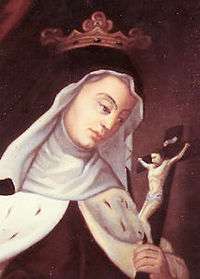Françoise d'Amboise
Françoise d'Amboise (9 May 1427[1] – 4 November 1485) was a French Roman Catholic declared "blessed" and a duchess consort of Brittany.
Blessed Françoise d’Amboise O. Carm. | |
|---|---|
 Blessed Françoise d'Amboise. | |
| Religious | |
| Born | 29 May 1427 Château de Thouars, Kingdom of France |
| Died | 4 November 1485 (aged 58) Nantes, Kingdom of France |
| Venerated in | Roman Catholic Church |
| Beatified | 16 July 1863, Saint Peter's Basilica, Papal States by Pope Pius IX |
| Feast | November 4 |
| Attributes |
|
She was born in the castle of Thouars. She was the daughter of the rich noble Louis d'Amboise, prince of Talmont and Viscount of Thouars, and Louise-Marie de Rieux.[2] To escape from the violence of the times, she fled with her mother to the court of Brittany, which resided in Vannes and, later on, in Nantes. At the age of three she had been engaged to Peter, the second son of John V, Duke of Brittany, for political reasons. She married him at the age of fifteen, in 1442.[2]
In 1450, after the unexpected death of Pierre's elder brother, her husband came to rule Brittany as Pierre II. Françoise d'Amboise became the Duchess of Brittany and had a discrete but active share in governing Brittany. She came to help the poor and the sick. She had also a strong feeling about justice. Her husband died of a disease in 1457. She then entered into a conflict with King Louis XI who wanted to marry her. A widow without children, she founded, together with Jean Soreth, the first monastery of the Carmelites in France, in 1463.
She took the veil a nun in 1468, when entering the convent of the Three Maries at Vannes.[2] She died in Nantes, at the monastery of the Carmelite nuns.
Notes
- Horae ad usum Namnetensem. 1401–1500.CS1 maint: date format (link)
- Diane E. Booton, Manuscripts, Market and the Transition to Print in Late Medieval Brittany, (Ashgate Publishing, 2010), 147.
- Susan Broomhall, Women and Religion in Sixteenth-Century France, (Palgrave Macmillan, 2006), 47.
References
- Eugène Lafolye, Compte des dépenses de Françoise d'Amboise, Editeur Vannes, 1889.
- J.-L. Chalnel, Histoire de la Touraine, 1841, tome IV.
- Zimmerman, Benedict (1909). . In Herbermann, Charles (ed.). Catholic Encyclopedia. 6. New York: Robert Appleton Company.
Françoise d'Amboise Born: 29 May 1427 Died: 4 November 1485 | ||
| Royal titles | ||
|---|---|---|
| Preceded by Isabella of Scotland |
Duchess consort of Brittany 1450-1457 |
Succeeded by Catherine of Luxembourg-Saint-Pol |